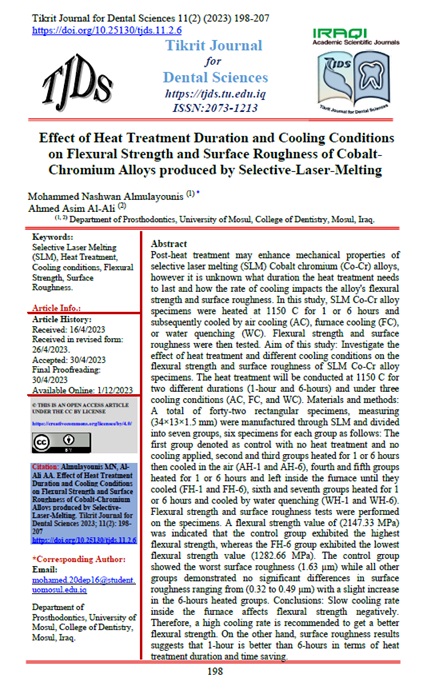Effect of Heat Treatment Duration and Cooling Conditions on Flexural Strength and Surface Roughness of Cobalt-Chromium Alloys produced by Selective-Laser-Melting
Mohammed Nashwan Almulayounis
Department of Prosthodontics, University of Mosul, College of Dentistry, Mosul, Iraq.
Ahmed Asim Ali
Department of Prosthodontics, University of Mosul, College of Dentistry, Mosul, Iraq.
DOI: https://doi.org/10.25130/tjds.11.2.6
Keywords: Selective Laser Melting (SLM), Heat Treatment, Cooling conditions, Flexural Strength, Surface Roughness.
Abstract
Post-heat treatment may enhance mechanical properties of selective laser melting (SLM) Cobalt chromium (Co-Cr) alloys, however it is unknown what duration the heat treatment needs to last and how the rate of cooling impacts the alloy's flexural strength and surface roughness. In this study, SLM Co-Cr alloy specimens were heated at 1150 C for 1 or 6 hours and subsequently cooled by air cooling (AC), furnace cooling (FC), or water quenching (WC). Flexural strength and surface roughness were then tested. Aim of this study: Investigate the effect of heat treatment and different cooling conditions on the flexural strength and surface roughness of SLM Co-Cr alloy specimens. The heat treatment will be conducted at 1150 C for two different durations (1-hour and 6-hours) and under three cooling conditions (AC, FC, and WC). Materials and methods: A total of forty-two rectangular specimens, measuring (34×13×1.5 mm) were manufactured through SLM and divided into seven groups, six specimens for each group as follows: The first group denoted as control with no heat treatment and no cooling applied, second and third groups heated for 1 or 6 hours then cooled in the air (AH-1 and AH-6), fourth and fifth groups heated for 1 or 6 hours and left inside the furnace until they cooled (FH-1 and FH-6), sixth and seventh groups heated for 1 or 6 hours and cooled by water quenching (WH-1 and WH-6). Flexural strength and surface roughness tests were performed on the specimens. A flexural strength value of (2147.33 MPa) was indicated that the control group exhibited the highest flexural strength, whereas the FH-6 group exhibited the lowest flexural strength value (1282.66 MPa). The control group showed the worst surface roughness (1.63 μm) while all other groups demonstrated no significant differences in surface roughness ranging from (0.32 to 0.49 μm) with a slight increase in the 6-hours heated groups. Conclusions: Slow cooling rate inside the furnace affects flexural strength negatively. Therefore, a high cooling rate is recommended to get a better flexural strength. On the other hand, surface roughness results suggests that 1-hour is better than 6-hours in terms of heat treatment duration and time saving




